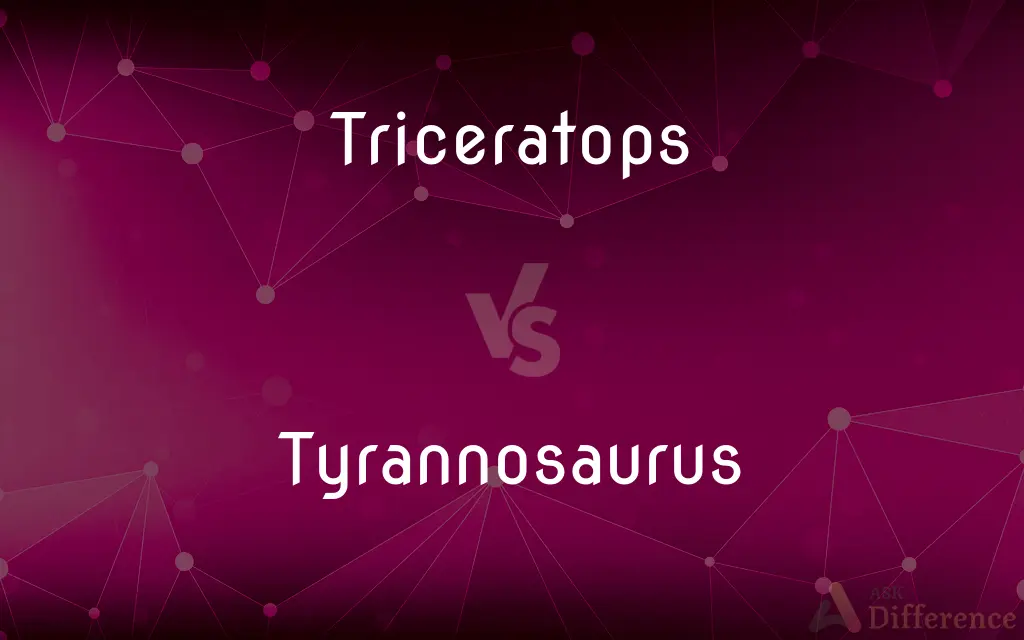Triceratops vs. Tyrannosaurus — What's the Difference?
By Tayyaba Rehman — Updated on October 7, 2023
Triceratops was a herbivorous dinosaur with three horns and a frill, while Tyrannosaurus was a carnivorous predator with sharp teeth and powerful jaws. Both lived during the Late Cretaceous period but had different lifestyles and features.

Difference Between Triceratops and Tyrannosaurus
Table of Contents
ADVERTISEMENT
Key Differences
Triceratops and Tyrannosaurus are both iconic dinosaurs that lived during the Late Cretaceous period, but they had vastly different appearances and lifestyles.
The Triceratops, as its name suggests, is most recognizable for its three prominent horns and the large frill at the back of its head. This dinosaur was herbivorous, feeding primarily on plants, with a sturdy build to support its weight.
In contrast, the Tyrannosaurus was a carnivorous beast, feared for its large size, powerful jaws, and sharp teeth. Its short arms and upright stance made it a unique predator, hunting and scavenging other dinosaurs and creatures.
While both Triceratops and Tyrannosaurus coexisted during the same time, they occupied different niches in their ecosystem. The Triceratops possibly used its horns and frill for defense, especially against predators like the Tyrannosaurus.
Comparison Chart
Diet
Herbivore
Carnivore
ADVERTISEMENT
Distinct Features
Three horns and a frill
Large jaws and sharp teeth
Size
About 30 feet in length
Up to 40 feet in length
Role in Ecosystem
Likely prey for large predators
Apex predator
Arms
Sturdy front limbs
Very short arms
Compare with Definitions
Triceratops
A herbivorous dinosaur known for its three facial horns.
The fossil remains of the Triceratops show a large frill and three horns.
Tyrannosaurus
A bipedal predator with tiny, almost vestigial arms.
Despite its small arms, the Tyrannosaurus was a formidable hunter.
Triceratops
A four-legged dinosaur with a sturdy build and bony frill.
The children marveled at the Triceratops skeleton at the museum.
Tyrannosaurus
Often abbreviated as T. rex, a symbol of dinosaur dominance.
The Tyrannosaurus or T. rex is a favorite among dinosaur enthusiasts.
Triceratops
A dinosaur that may have used its horns for defense.
Some scientists believe the Triceratops used its horns to fend off predators.
Tyrannosaurus
A dinosaur with a keen sense of smell and possibly binocular vision.
The Tyrannosaurus might have used its heightened senses to track prey.
Triceratops
A member of the ceratopsian family of dinosaurs.
The Triceratops is one of the most well-known ceratopsians.
Tyrannosaurus
A large carnivorous dinosaur with powerful jaws.
The Tyrannosaurus was one of the top predators of its time.
Triceratops
A Late Cretaceous dinosaur with a beak-like mouth for eating plants.
The Triceratops roamed the plains, grazing on low-lying vegetation.
Tyrannosaurus
A theropod dinosaur from the Late Cretaceous period.
Fossil evidence shows the Tyrannosaurus had sharp teeth for tearing flesh.
Triceratops
Triceratops is an extinct genus of herbivorous ceratopsid dinosaur that first appeared during the late Maastrichtian stage of the Late Cretaceous period, about 68 million years ago in what is now North America. It is one of the last-known non-avian dinosaur genera, and became extinct in the Cretaceous–Paleogene extinction event 66 million years ago.
Tyrannosaurus
Tyrannosaurus is a genus of tyrannosaurid theropod dinosaur. The species Tyrannosaurus rex (rex meaning "king" in Latin), often called T. rex or colloquially T-Rex, is one of the best represented of these large theropods.
Triceratops
A large ceratopsian dinosaur of the genus Triceratops of the Cretaceous Period, having a large bony frill at the back of the skull, a pair of horns above the eyes, and a single horn on the nose.
Tyrannosaurus
Any of various tyrannosaurid dinosaurs of the genus Tyrannosaurus, having a large head and teeth and short forelimbs, and including T. rex and possibly some other species. Also called tyrannosaur.
Triceratops
Common name of the extinct genus Triceratops; herbivorous ceratopsids from the late Cretaceous.
Tyrannosaurus
See T. rex.
Triceratops
Huge ceratopsian dinosaur having three horns and the neck heavily armored with a very solid frill
Tyrannosaurus
A large carnivorous dinosaur, of the genus Tyrannosaurus, found in North America during the late Cretaceous period.
Tyrannosaurus
Large carnivorous bipedal dinosaur having enormous teeth with knifelike serrations; may have been a scavenger rather than an active predator; later Cretaceous period in North America
Common Curiosities
Were the horns of the Triceratops used for defense?
It's believed that the Triceratops used its horns for defense against predators.
What does the name "Triceratops" mean?
"Triceratops" means "three-horned face."
What did the Triceratops eat?
The Triceratops was herbivorous, feeding on plants.
How many fingers did the Triceratops have on each hand?
The Triceratops had three fingers on each hand.
What distinguishes the Tyrannosaurus from other carnivorous dinosaurs?
The Tyrannosaurus had unique features like large jaws, sharp teeth, and very short arms.
How large could a Tyrannosaurus grow?
A Tyrannosaurus could grow up to 40 feet in length.
Why did the Tyrannosaurus have such small arms?
The exact reason is unclear, but they might not have been crucial for its hunting style.
Did the Triceratops have any predators?
Yes, the Triceratops likely had predators, possibly including the Tyrannosaurus.
Was the Tyrannosaurus an apex predator?
Yes, the Tyrannosaurus was considered an apex predator of its ecosystem.
Was the Triceratops a social animal?
Some evidence suggests that the Triceratops might have lived in herds.
Was the Tyrannosaurus purely a hunter?
The Tyrannosaurus was likely both a hunter and a scavenger.
Did the Triceratops and Tyrannosaurus live at the same time?
Yes, both the Triceratops and Tyrannosaurus lived during the Late Cretaceous period.
How many horns did the Triceratops have?
The Triceratops had three horns.
How fast could the Tyrannosaurus run?
Estimates vary, but some scientists believe the Tyrannosaurus could run up to 15 mph.
Are the Triceratops and Tyrannosaurus frequently depicted in popular culture?
Yes, both the Triceratops and Tyrannosaurus are popular and iconic dinosaurs in media and literature.
Share Your Discovery

Previous Comparison
Decree vs. Fiat
Next Comparison
Algorithm vs. FlowchartAuthor Spotlight
Written by
Tayyaba RehmanTayyaba Rehman is a distinguished writer, currently serving as a primary contributor to askdifference.com. As a researcher in semantics and etymology, Tayyaba's passion for the complexity of languages and their distinctions has found a perfect home on the platform. Tayyaba delves into the intricacies of language, distinguishing between commonly confused words and phrases, thereby providing clarity for readers worldwide.














































